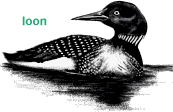
 |
 Found throughout Michigan,
wetlands, such as wet meadows,
marshes, swamps, and peatlands, originally covered 11 million acres or about one-third of the state's landmass. During the last 200 years, over 35 percent of these wetlands have been drained or filled for agricultural fields, building projects, or other human purposes. Chemical contamination, isolation, and
fragmentation have also contributed to the loss of wetlands. Fragmentation occurs when roads, trails, homes, and other forms of development break up the wetland area. Found throughout Michigan,
wetlands, such as wet meadows,
marshes, swamps, and peatlands, originally covered 11 million acres or about one-third of the state's landmass. During the last 200 years, over 35 percent of these wetlands have been drained or filled for agricultural fields, building projects, or other human purposes. Chemical contamination, isolation, and
fragmentation have also contributed to the loss of wetlands. Fragmentation occurs when roads, trails, homes, and other forms of development break up the wetland area.
Since wetland birds rely on moist areas for food and cover, wetland losses have caused the decline of many of these species including least bitterns, yellow rails, black-crowned night herons, Forster's tern, and marsh and sedge wrens. More than half of all remaining Michigan wetlands are less than one acre in size. Bird species that inhabit small swamps and other wetlands include red-winged blackbirds, yellow warblers, green herons, woodcock and tree swallows. Therefore, protecting or restoring wetlands on your property may help increase wetland bird populations. The wetlands and associated uplands that are present on your property will determine what species of wetland birds will be attracted. It is important to remember that some wetlands are not always wet. Seasonal wetlands, for example, may contain water only during wet periods in the spring and fall. All wetlands, however, are important to wildlife. Waterfowl, shorebirds,
Many different wetland birds are attracted to a variety of wetlands based on the type of food and cover provided. For example, plovers and sandpipers are attracted to shorelines with little vegetation where they nest, and find insects and other food. Bitterns, yellow rails, and herons are wading species that depend upon shallow water with cattails, bulrush, and smartweed to provide food such as small fish, frogs, and invertebrates such as snails, crayfish, and insects. The type of food and cover present in a wetland is based on water levels and vegetation composition. Throughout the year, different types of wetlands contain varying depths of water, or no water at all, which determines the type of vegetation that will grow there. Wetlands with both dense and sparse stands of vegetation provide food and cover for specific types of birds. Some wetland cover types include dense cattail stands, grassy meadows, and wooded swamps. Sedge fields, wet meadows, mud flats, and beaches all provide good food sources, including insects and seeds, for a variety of wetland birds. The food and cover needs of many bird species also varies by seasonal activity. Migration stop-over, pair bonding, nesting, and brood rearing often require different components of a wetland. In general, if you want to attract and manage for a diversity of wetland birds, restore and protect several wetlands or a diversity of wetland types, which will provide a variety of food and cover. Cover Types for Wetland BirdsBecause each wetland is different from the other, a different management prescription may be involved for each. For more information refer to the Wetland Management section. Wet meadows are seasonally wet and often have less than six inches of water depth at any given time. The following are options to consider when managing for wet meadows.
Shorelines can consist of beaches, mud flats, and rocky areas. At times, shorelines can border ponds, lakes, streams, or marshes. Shorebird species that use mud flats include dowitchers, common snipe, semi-palmated sandpipers and dunlin. Plover, sandpipers, yellowlegs, and gulls can be found on beaches. Swamps, that are located near rivers, lakes, and streams are usually wet in spring, dry in summer, and sometimes wet again in fall. Lowland hardwoods, or swamps, typically have water less than a foot deep, and they harbor ash, maple, swamp white oak, basswood, cottonwood, and other broadleaf trees. The rose-breasted grosbeak, eastern wood-pewee, red-eyed vireo, white-breasted nuthatch, downy woodpecker, veery, and willow, alder and great-crested flycatchers are forest songbirds that inhabit forested wetlands. Swamps are also important to red-shouldered hawks, and can provide the structures for great blue heron rookeries. Another type of swamp is the wet conifer forests which contain tamarack, balsam fir, black spruce, and white cedar. These wetlands attract forest-dwelling species such as the yellow-bellied flycatcher, golden-crowned kinglet, white-throated sparrow, red-breasted nuthatch, nashville warbler, black-and-white warbler, American goldfinch and cedar waxwing. Peatlands are classified into bogs and fens. They contain a wide variety of vegetation from sedges or brush to broadleaf trees or evergreens. Alder flycatchers, swamp sparrows, rufous-sided towhees, palm warblers, hermit thrushes, and sandhill cranes are attracted to peatlands. Open peatlands may also contain shrub wetlands, which are favored by common yellowthroats, chestnut-sided warblers, song sparrows, and red-winged blackbirds. Management ConsiderationsTo meet the diverse needs of wetland birds, landowners should protect existing wetlands and restore former wetlands when feasible. What follows are general management considerations that apply to most wetlands.
In summary, many bird groups rely on wetlands for food, shelter, water and living space. The more diverse a wetland is, the greater variety of birds it will attract. Multiple wetlands in close proximity, connected by grass/woody corridors, result in greatest wetland bird abundance and diversity. Healthy wetlands are dynamic and diverse, and when coupled with abundant upland cover, provide habitat to a greater variety of birds for nesting, brood rearing, and migrational stages. Protect all wetlands on your property and restore former wetlands when feasible.
Last Revised: December 12, 1999 |
|